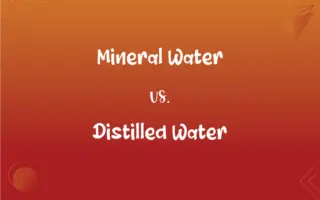Transamination vs. Deamination: What's the Difference?
Edited by Aimie Carlson || By Janet White || Published on January 8, 2024
Transamination involves the transfer of an amino group from one amino acid to a keto acid. Deamination is the removal of an amino group from an amino acid.

Key Differences
Transamination is a biochemical process where an amino group is transferred from one amino acid to a keto acid, forming a new amino acid. Deamination involves the removal of an amino group from an amino acid, often producing ammonia and a keto acid.
Transamination is crucial in synthesizing non-essential amino acids and in amino acid metabolism. Deamination, on the other hand, is significant in the catabolism of amino acids, particularly in nitrogen excretion and energy production.
Enzymes called transaminases or aminotransferases facilitate transamination. In deamination, enzymes like deaminases or oxidative deaminases catalyze the reaction.
Transamination often occurs in the liver and is a reversible process, important in adapting to different dietary needs. Deamination is critical in detoxifying excess amino acids and can occur in various tissues, including the liver and kidneys.
Transamination reactions are vital for the biosynthesis of various amino acids and maintaining nitrogen balance in cells. Deamination is crucial for the urea cycle, processing nitrogenous waste for excretion.
ADVERTISEMENT
Comparison Chart
Process
Transfer of an amino group
Removal of an amino group
Significance
Synthesis of non-essential amino acids
Nitrogen excretion, energy production
Enzymes Involved
Transaminases
Deaminases
Occurrence
Mainly in the liver, reversible
Liver, kidneys, irreversible in some cases
Role in Metabolism
Biosynthesis of amino acids, nitrogen balance
Urea cycle, detoxification of amino acids
ADVERTISEMENT
Transamination and Deamination Definitions
Transamination
The biochemical transfer of an amino group from one molecule to another.
Transamination is essential for the metabolism of amino acids in the body.
Deamination
The removal of an amino group from an amino acid.
Deamination is a step in the catabolism of proteins.
Transamination
A process crucial in producing non-essential amino acids.
Transamination reactions help in synthesizing various non-essential amino acids.
Deamination
Often results in the production of ammonia and a keto acid.
The deamination of amino acids in the liver produces ammonia, later converted to urea.
Transamination
Helps in adapting the body's nitrogen metabolism to dietary changes.
Transamination allows the body to utilize different dietary amino acids efficiently.
Deamination
Important for the urea cycle, detoxifying amino acids.
The urea cycle relies on deamination to process nitrogenous waste.
Transamination
Involves enzymes known as transaminases or aminotransferases.
Alanine aminotransferase is a key enzyme in transamination.
Deamination
Involves enzymes like deaminases or oxidative deaminases.
Glutamate dehydrogenase plays a significant role in oxidative deamination.
Transamination
A reversible biochemical reaction in amino acid synthesis.
Transamination reactions can be reversed, depending on the body's needs.
Deamination
Essential for nitrogen excretion and energy production.
Deamination is crucial for removing excess nitrogen from the body.
Transamination
Transfer of an amino group from one chemical compound to another.
Deamination
To remove an amino group, NH2, from (an organic compound).
Transamination
Transposition of an amino group within a chemical compound.
Deamination
(organic chemistry) The removal of an amino group from a compound.
Transamination
(biochemistry) the transfer of an amino group from an amino acid to another molecule
Deamination
Removal of the amino radical from an amino acid or other amino compound
Transamination
The process of transposing an amino group within a chemical compound
Transamination
The process of transfering an amino group from one compound to another
FAQs
Why is transamination important in metabolism?
It helps synthesize non-essential amino acids.
What does deamination accomplish?
Removes an amino group, producing ammonia.
Can transamination occur in muscles?
Yes, it's part of amino acid metabolism.
What is transamination?
Transfer of an amino group between molecules.
How does deamination relate to the urea cycle?
It provides ammonia for urea synthesis.
What are the products of deamination?
Ammonia and a keto acid.
What enzymes catalyze deamination?
Deaminases, like glutamate dehydrogenase.
What role does deamination play in protein breakdown?
It helps in catabolizing amino acids for energy.
Is deamination a reversible process?
It's usually irreversible.
Can deamination affect blood pH?
Yes, as it produces ammonia, which can influence pH.
How does transamination support nitrogen balance?
By transferring amino groups, it helps maintain cellular nitrogen levels.
Are transamination reactions reversible?
Yes, depending on the body's needs.
How is transamination regulated in the body?
Through enzyme activity and availability of substrates.
Is transamination specific to certain amino acids?
It involves many amino acids but is specific to their structure.
Which enzymes are involved in transamination?
Transaminases or aminotransferases.
What are the dietary implications of transamination?
It allows flexibility in using dietary amino acids.
What conditions increase deamination?
High protein intake or certain metabolic conditions.
Is deamination harmful in excess?
Excessive deamination can lead to high ammonia levels, which is toxic.
What is the end product of ammonia from deamination?
It's converted to urea for excretion.
Does transamination produce energy?
Indirectly, by aiding in amino acid metabolism.
About Author
Written by
Janet WhiteJanet White has been an esteemed writer and blogger for Difference Wiki. Holding a Master's degree in Science and Medical Journalism from the prestigious Boston University, she has consistently demonstrated her expertise and passion for her field. When she's not immersed in her work, Janet relishes her time exercising, delving into a good book, and cherishing moments with friends and family.
Edited by
Aimie CarlsonAimie Carlson, holding a master's degree in English literature, is a fervent English language enthusiast. She lends her writing talents to Difference Wiki, a prominent website that specializes in comparisons, offering readers insightful analyses that both captivate and inform.






































































